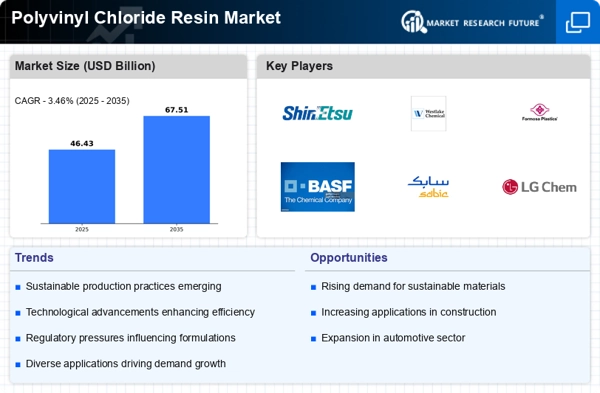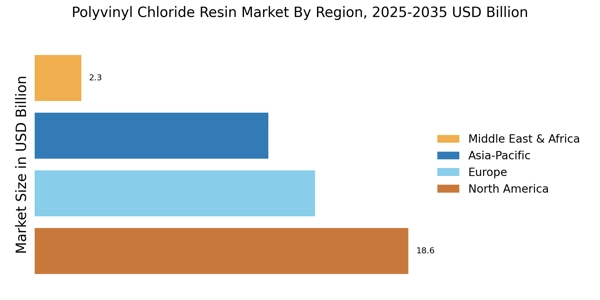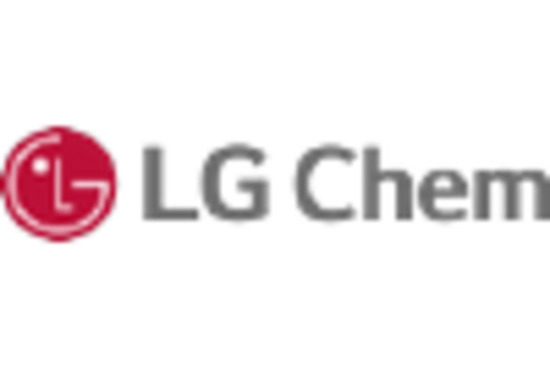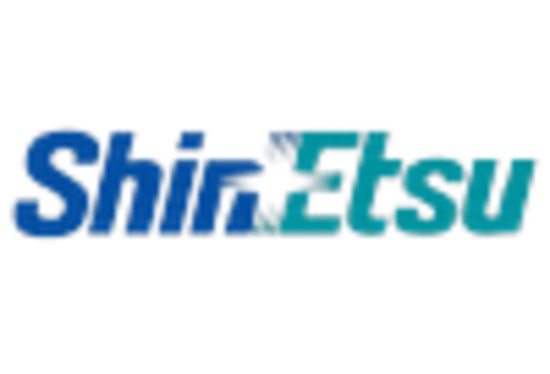Growth in Automotive Applications
The automotive industry is increasingly adopting Polyvinyl Chloride Resin Market, which serves as a crucial driver for the Polyvinyl Chloride Resin Market. PVC is utilized in various automotive components, including interior trims, dashboards, and wiring insulation, due to its lightweight and versatile properties. As the automotive sector shifts towards electric vehicles, the demand for lightweight materials is expected to rise, potentially increasing the use of PVC. In 2025, the automotive market is anticipated to grow by around 4%, which may lead to a corresponding increase in PVC consumption. This trend suggests that the automotive industry's evolution could significantly impact the Polyvinyl Chloride Resin Market, fostering innovation and new applications.
Rising Demand in Construction Sector
The construction sector appears to be a primary driver for the Polyvinyl Chloride Resin Market. With increasing urbanization and infrastructure development, the demand for PVC in building materials such as pipes, windows, and flooring is on the rise. In 2025, the construction industry is projected to grow at a rate of approximately 5.5% annually, which could significantly boost the consumption of PVC resin. This material's durability, resistance to corrosion, and low maintenance requirements make it a preferred choice among builders and architects. Furthermore, the trend towards sustainable building practices may enhance the appeal of PVC, as it can be recycled and reused, aligning with environmental goals. Thus, the construction sector's expansion is likely to propel the Polyvinyl Chloride Resin Market forward.
Increasing Use in Packaging Solutions
The packaging industry is witnessing a notable shift towards the use of Polyvinyl Chloride Resin Market, which serves as a vital driver for the Polyvinyl Chloride Resin Market. PVC is favored for its clarity, strength, and barrier properties, making it suitable for food and pharmaceutical packaging. As consumer preferences lean towards convenience and safety, the demand for PVC in packaging is likely to grow. In 2025, the packaging sector is projected to expand at a rate of approximately 3.5%, which could enhance the market for PVC resin. This growth may be further supported by regulatory measures promoting safer packaging materials. Consequently, the increasing reliance on PVC in packaging solutions is expected to bolster the Polyvinyl Chloride Resin Market.
Technological Innovations in Production
Technological advancements in the production of Polyvinyl Chloride Resin Market are emerging as a significant driver for the Polyvinyl Chloride Resin Market. Innovations such as improved polymerization techniques and the development of bio-based PVC are enhancing production efficiency and reducing environmental impact. These advancements may lead to lower production costs and higher quality products, making PVC more competitive against alternative materials. In 2025, the introduction of new technologies is likely to facilitate a more sustainable production process, which could attract environmentally conscious consumers. As a result, the ongoing technological innovations are expected to play a crucial role in shaping the future of the Polyvinyl Chloride Resin Market.
Regulatory Support for Sustainable Materials
Regulatory frameworks promoting sustainable materials are increasingly influencing the Polyvinyl Chloride Resin Market. Governments are implementing policies aimed at reducing plastic waste and encouraging the use of recyclable materials. This regulatory support may drive the demand for PVC, particularly in applications where recyclability is emphasized. In 2025, the implementation of stricter regulations on plastic usage could lead to a surge in demand for sustainable alternatives, including PVC. The material's ability to be recycled multiple times aligns with these regulatory trends, potentially enhancing its market position. Therefore, the evolving regulatory landscape is likely to serve as a catalyst for growth within the Polyvinyl Chloride Resin Market.


















Leave a Comment